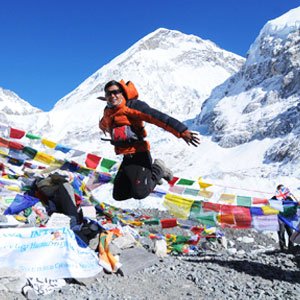Top Peaks to Climb in Nepal
Among the many trekking peaks in Nepal, there are a few that are very popular between beginner and experienced climbers. Because of their zero-to-less technical difficulties and fantastic exposure to the Himalayan environment, the below peaks offer an ideal ground for building your mountaineering expertise.
We have well-tested itineraries and the best cost for the below climbing packages. With our team's support and care, we believe anyone can conquer these mountains. Get in touch with us now for more information. We would love to hear from you and help you organize a hassle-free and safe climbing expedition in Nepal.
Mera Peak (6,476 m/21,246 ft)
Mera Peak is the highest trekking peak in Nepal. It is the most sought-after climbing peak for beginners in the Himalayas. This non-technical yet physically challenging peak offers a perfect introduction to mountaineering in the Himalayas. Our Mera Peak climbing itinerary is 18 days Mera Peak climbing cost starts from USD 2,300 per person.
Following our Mera Peak climbing itinerary, you trek for a few days to reach Khare. It is the base camp. Here, you will spend two nights and also get pre-climbing training from your leader. From here, you will climb to Mera High Camp and spend a night there before pushing towards the summit.
On the Mera Peak climbing, you will get to witness stunning mountain views of Everest, Lhotse, Cho Oyu, Kanchenjunga, Makalu, and many others. The journey starts with adventurous trekking via remote villages and meadows to the base camp. Get to see lush vegetation and the lifestyle of the locals along the way.
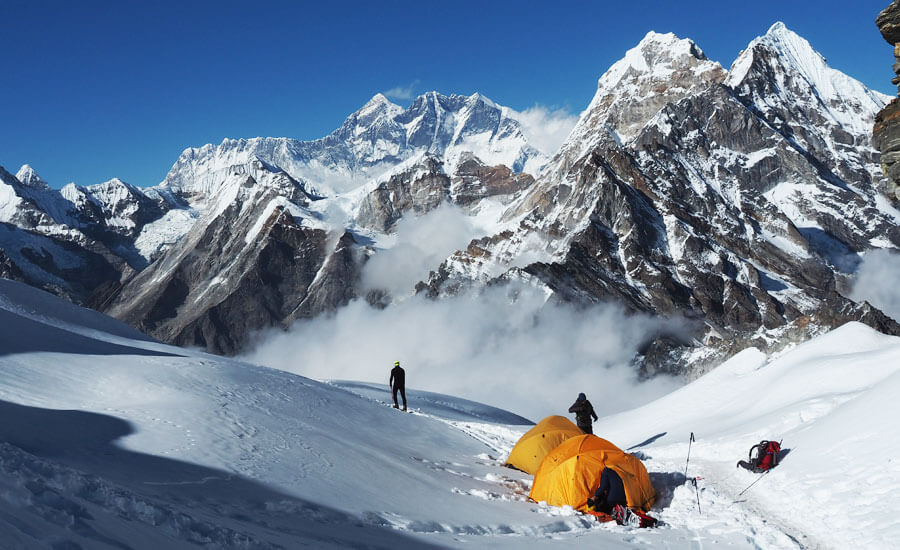
Island Peak (6,165 m/20,226 ft)
Island Peak is the second most famous trekking peak after Mera Peak. It is also a beginner-friendly climbing peak with fewer technical sections and a fantastic mountaineering experience. Island Peak climbing itinerary is usually 14 days to 22 days long. The Island Peak climbing cost starts from USD 2,050 per person. The cost can differ as per the itinerary.
Following our Island Peak climbing itinerary, you will trek to Everest Base Camp and Kala Patthar. Likewise, you will also cross the Kongma La pass. These hikes allow you to well-acclimatize before reaching the Island Peak Base Camp. We will make a high camp at 5,600 meters and push to the summit from here.
Island Peak climbing is one of the best ways to explore the beauty of the Everest region. You will get to enjoy trekking via rhododendron forests and beautiful Sherpa villages. Explore ancient monasteries and get to see the daily lifestyle of the locals. The journey offers heavenly mountain views and diverse landscapes.
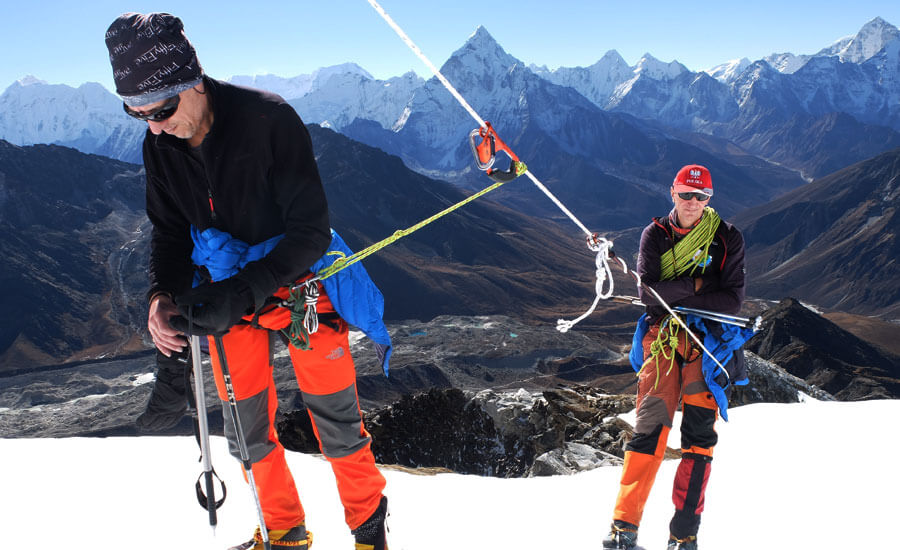
Lobuche Peak (6,119 m/20,075 ft)
Lobuche Peak is also quite famous for its incredible mountaineering adventure. This peak has two summits- Lobuche East (6,119 m) and Lobuche West (6,145 m). The Lobuche East Peak is a trekking peak and easy to climb because of less technical difficulties. However, Lobuche West Peak is an expedition peak and requires technical climbing.
We will briefly introduce the Lobuche East Peak climbing here. The peak is located above the Lobuche village and the Khumbu glacier. You will get to see close views of Mt. Everest, Mt. Lhotse, Mt. Ama Dablam, Mt. Thamserku, Mt. Baruntse, Mt. Pumori, and many others during the journey. Lobuche Peak climbing cost starts from 2050 USD per person. The crowd on the Lobuche Peak is less than the Mera Peak and Island Peak.
You will start the Lobuche Peak climbing with a Lukla flight. Follow the mainstream EBC trail and hike to Kala Patthar for acclimatization. Above the Lobuche Peak Base Camp, we will make the Lobuche Peak High Camp and push towards the summit. The climbing part is definitely physically taxing but very rewarding.
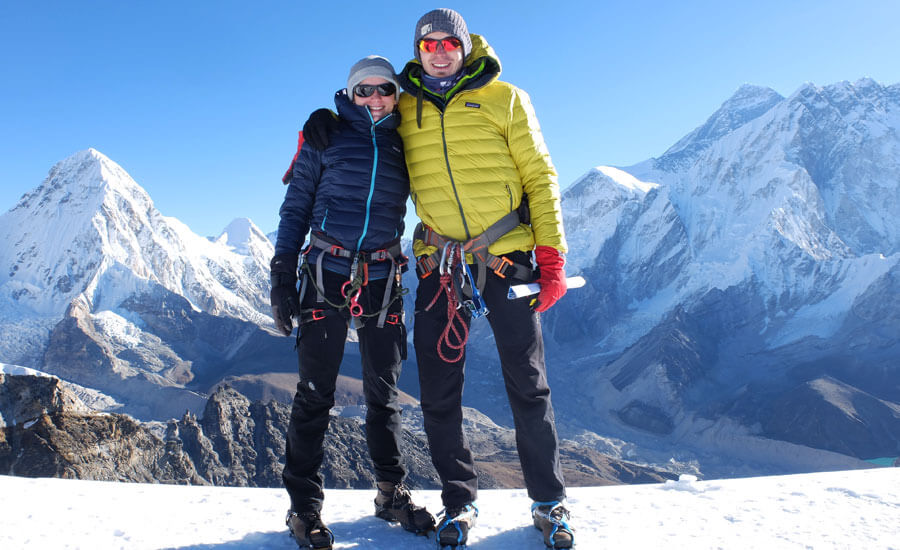
Himlung Peak (7,126 m/23,379 ft)
Himlung Himal is a popular expedition peak in Nepal. It is a perfect mountain to start serious mountaineering in the Himalayas. There are some technical sections along the climbing route. It will help you polish your climbing skills and grow as a climber. Himlung Himal climbing is much more challenging than the above three trekking peaks.
Located in the Annapurna region, the Himlung Himal has the highest summit success rate than other 7,000-meter mountains. This mountain is located near the border between Nepal and Tibet. The journey to its base camp is adventurous, beautiful, and a lifetime experience.
You will get to witness jaw-dropping views of many mountains, including Annapurna and Manaslu, along the way. The Himlung Himal climbing cost starts at USD 9,050 per person and may vary as per the group size, itinerary, and services included in the package cost.
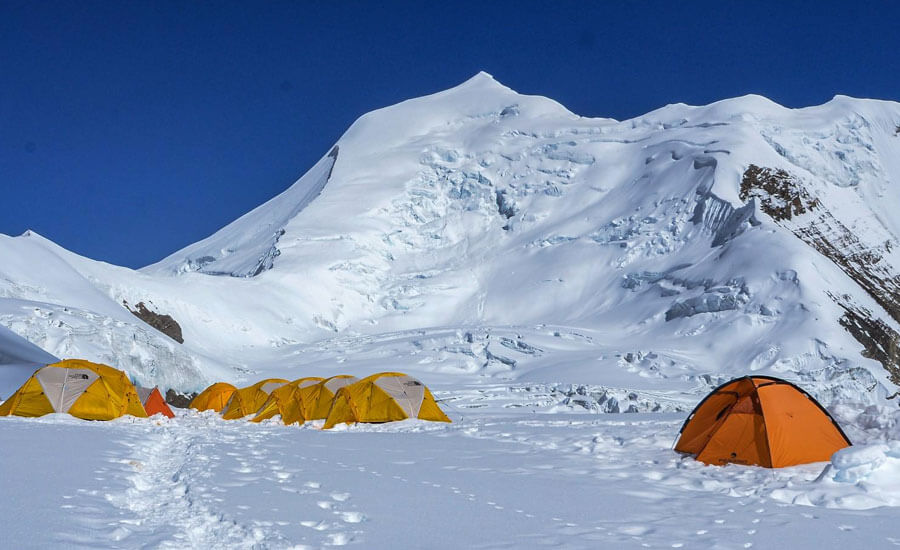
Frequently Asked Questions About Peak Climbing in Nepal
What is the most climbed mountain in Nepal?
Nepal has numerous mountains ranging from 5,000 meters to 8,000 meters and above. Island Peak and Mera Peak, located on either side of the Everest region, are one of the most climbed mountains in Nepal. They are beginner-friendly peaks to climb and provide a perfect introduction to peak climbing in the Himalayas.
Which is the best 6000m peak to climb in Nepal?
Mera Peak (6,476 m) and Island Peak (6,189 m) are the two best 6000-meter peaks to climb in Nepal. These peaks are famous for their nontechnical climbing route.
Climbers get ideal exposure to the Himalayan environment and learn basic climbing skills. Likewise, Ama Dablam (6,812 m) is another fantastic 6000m, however, it is an expedition mountain and is only recommended to veteran climbers.
What are the three peaks climbing in Nepal?
The three famous climbing peaks in Nepal are Mera Peak, Island Peak, and Lobuche Peak. These peaks are situated in the Everest region and offer a fantastic climbing experience.
Which is the easiest peak to climb in Nepal?
Among all the peaks in Nepal, these are some of the easiest peaks one can climb- Pokalde Peak, Mera Peak, and Lobuche Peak. These peaks are easy in terms of non-technical climbing, however, the participants have to be physically and mentally strong to face the high altitude challenges and unpredictable Himalayan weather.
What are the legal requirements and permits needed for peak climbing in Nepal?
Participants have to meet specific legal requirements for peak climbing in Nepal. It includes getting permits issued by the Nepal Mountaineering Association (NMA), local municipalities, and national park authorities.
As per the location of the mountain, different permits are required. Likewise, it is mandatory to climb a peak in Nepal with a local travel company like us. Our team will help you obtain all the permits without any hassle.
How do I choose the right peak to climb based on my skill level and experience?
You have to carefully consider your fitness and expertise while choosing a peak to climb in Nepal. Luckily, Nepal has both beginner-friendly and advanced mountains that allow avid climbers to choose from a big pool.
Likewise, you can consult our professional mountaineers. They will help you assess your climbing skills, fitness level, and high-altitude experience and help you pick the right mountain to climb.
What are the best seasons for peak climbing in Nepal?
The best seasons for peak climbing in Nepal are spring (pre-monsoon) and post-monsoon (autumn). Spring, March to May, is a perfect time for climbing in the Himalayas. Most of the 7,000-meter and 8,000-meter mountains are climbed in spring because of excellent visibility, stable weather, and multiple climbing windows.
It is also a great time to climb 6,000-meter mountains. Likewise, autumn, September to November, is another great time of the year to climb mountains because of favorable weather and climate.
What type of training or preparation is necessary before attempting a peak climb in Nepal?
If you are planning to climb a peak in Nepal, then you will need to undergo thorough training and preparation. It includes building your physical strength, improving your stamina, and working on your endurance. You have to do different training like strength training and endurance activities to get your mind and body ready for climbing.
Additionally, you can go on hikes and treks to improve your high-altitude tolerance. As for climbing skills, you can join workshops. Our team provides pre-climbing training at the base camp of the mountains to boost the confidence of the participants.
What are the risks and safety measures associated with peak climbing in Nepal?
Peak climbing in general comes with various risks like injuries, altitude sickness, accidents, avalanches, rockfall, etc. Whether you are climbing a peak in Nepal or any other country, there are always risks associated with it.
However, it doesn't mean you should not climb. With proper preparations and expert support, you can climb a peak in Nepal without any issues. Our experienced team assures your safety during climbing. They are trained to provide any medical emergency and have many years of experience.
Likewise, we also have a well-planned and tested rescue plan. It allows you to climb freely as our rescue team stays on standby during the climbing period in case we have to evacuate you. We make sure our guests are safe and sound during peak climbing in Nepal with us.
How much does it cost to climb a peak in Nepal, including permits, guides, equipment, and other expenses?
Climbing a peak in Nepal costs a lot of money because of several factors like permits, Sherpa guides and porter expenses, transportation, food, accommodations, etc. Additionally, you will also need money for climbing clothes and gear, essentials, travel insurance, tips, international flights, personal expenses, etc.
Likewise, depending on the services included in your climbing package, the cost may vary. Mera Peak, Island Peak, Lobuche Peak, etc, come under trekking peaks in Nepal. They do not require a long time or long acclimatization days at the base camp.
So, you can expect to pay USD 2,800 to USD 4,500 per person. Similarly, 7,000m and 8,000m mountain climbing costs start at USD 50,000 and above per person.
What are the accommodation options during a peak climbing expedition in Nepal?
During a peak climbing expedition in Nepal, you will spend the first handful of days of the trip trekking to the peak. The trekking time lasts anywhere from 7 to 9 days. During trekking, you will spend nights in lodges or tea houses.
These are basic accommodation services along the trails in the Himalayas. Twin shared rooms are mostly common, especially in the remote areas. Likewise, at the base camp and higher camps, we will provide you with alpine tents.
The tents will be managed by our supporting crew. Likewise, our team also takes care of cooking meals. You will get a comfortable bed with heating liners, blankets, and pillows in the tents. Climbers get separate sleeping tents & common washrooms and dining tents.
Are there any age restrictions for peak climbing in Nepal?
In Nepal, we do not have any age restrictions for climbing a peak, but the participants must meet the required physical and mental conditions to join the expedition. Climbers under 18 years old have to be accompanied by an identified guardian for the trip.
We have a huge record of young climbers conquering the Himalayan mountains in Nepal, so you do not have to worry. Whatever your age, our expert fleet of Sherpa guides and porters will be there with you in the mountains every minute to ensure your safety and enjoyment.
What are the environmental considerations and guidelines for responsible climbing in Nepal?
The Nepal government has set some specific rules that climbers have to adhere to minimize the ecological impact during their expedition. These guidelines include practicing Leave No Trace principles, which emphasize minimizing waste, properly disposing of trash, and avoiding damage to natural habitats.
Likewise, climbers also have to respect local customs and traditions. While returning from the higher camps and base camp, climbers have to pick up all their waste and dispose of it properly. While doing any peak climbing with us, Adventure White Mountain, you will only leave your footprint behind.
How do I find a reputable guide or climbing company for my peak climbing expedition in Nepal?
Your supporting team will make or break your peak climbing experience in Nepal, so it is very important to find the best Nepali local company to climb a mountain in the Himalayas. The company should not only meet your requirements and possess firm knowledge about peak climbing but also align with eco-friendly conventions.
You can thoroughly research their years of expertise, service quality, reviews, price, and vision. Given the potential risk of climbing a peak in the Himalayas, we recommend you go with a company with a proven track record. You can also inquire about your team leader's expertise.
Also, do not forget to check the credentials of the company and see whether they are certified by the International Federation of Mountain Guides Associations (IFMGA) or the Nepal Mountaineering Association (NMA). Finally, talk with the team and share your expectations. Have a clear communication.
What kind of equipment do I need for peak climbing in Nepal, and can I rent it locally?
To climb a peak in Nepal, you will need special equipment that will help you navigate the challenging Himalayan terrain and environment. Some essential gear is mountaineering boots, crampons, harnesses, helmets, ice axes, carabiners, ropes, ladders, climbing clothes, etc.
Likewise, you will also need sleeping bags, tents, backpacks, duffel bags, cooking equipment, food, and toiletries. The quality of the equipment must be great to use during peak climbing. When you book peak climbing in Nepal with us, our team will send you a comprehensive packing list.
Similarly, you can buy or rent climbing gear as per your wish. We will recommend the best rental place in Kathmandu and Pokhara from where you can rent peak climbing essentials at a very nominal price.
Are there any medical considerations or health risks associated with peak climbing at high altitudes in Nepal?
Yes, there are medical considerations and health risks associated with peak climbing at high altitudes in Nepal. For example, you will be exposed to extreme weather conditions and elevation that may trigger altitude sickness or other general discomfort. These conditions may also get worse if not treated properly.
Likewise, as high you gain, the air thins out, and the oxygen level gets low. This makes you exhausted sooner than you may think. You may have difficulty breathing. Likewise, the terrain is also not easy. There are risks of injuries and avalanches. You have to be very attentive while climbing because one wrong move may hamper your safety.
Meet your doctor and get all the medicine prescribed for the journey. Make sure you are physically and mentally ready for the high-altitude challenges. Train yourself adequately and most importantly, listen to your guide's instructions to avoid unseen situations that may hurt you.
What is the typical duration of a peak climbing expedition in Nepal?
It depends on the peak you are climbing. For instance, Mera Peak and Island Peak climbing takes a little over two weeks to complete. Trekking peaks does not require that long of a time to conquer. The majority of the time you spend during trekking peak climbing is traveling to/from the base camp of the peak.
On the trekking peak, we usually do not make higher camps. So, you will push for the summit directly from the base camp and return to the base camp the same day. This allows avid climbers to climb a peak quickly without spending much time at very high altitudes.
However, if you are a part of the expedition program, you will spend many days at the base camp and doing rotation climbs to higher camps to acclimatize. Expedition peaks and mountains require a longer time and may last more than a month.
How difficult is it to acclimatize to high altitudes during peak climbing in Nepal?
Acclimatizing to high altitudes requires patience. Depending upon the fitness and past expertise of the participants and the height of the peak, the acclimatization time differs. If you are an active climber and have past climbing experience, then you may not have to spend a long time acclimatizing during peak climbing in Nepal.
Acclimatization is a crucial part of climbing a peak in the Himalayas. It assures the safety of the climbers as they ascend to higher camps. If you are not acclimating, the harsh environment and low oxygen level will harm your mind and body and make you prone to altitude sickness.
To acclimatize, you spend many days at the base camp and hike high and low sleep. When climbing a 7,000m or 8,000m mountain, climbers usually spend two to four weeks acclimatizing.
Are there any cultural or etiquette considerations I should be aware of when climbing peaks in Nepal?
Whether you are climbing a peak in Nepal, exploring the sea in some other country, or doing any other activity in any country, you have to be respectful towards the country and its residents and beliefs.
Even though peak climbing in Nepal is all about traveling in untouched isolated parts of the Himalayas, you will still come across well-rooted mountain communities who have been living amidst mountains and worshiping them as their gods.
You have to be respectful of their way of life, traditions, and faiths. You are not allowed to question the local's beliefs or mock them. You are allowed to be curious and understand them closely, but disrespect is not acceptable.
Locals of the mountains in Nepal are very friendly, kind, and welcoming. Respect them & they will make your time in the Himalayas the most memorable moment of your life. Learn about some basic Nepali phrases and etiquette. Do not litter the trail or the mountains. Embrace the diverse Nepali culture and belief systems.
What are some recommended routes or itineraries for peak climbing in Nepal?
Nepal has uncountable numbers of peaks and mountains. The entire upper northern section of the country is lined with mountains. As per your knowledge and experience of climbing, you can choose the peak to climb. There are both beginner-friendly and advanced mountains in Nepal that one can climb.
For example- if you are climbing for the first time, consider Mera Peak, Island Peak, Lobuche Peak, Poklade Peak, etc. Likewise, for a bit of technical experience, you can go for Pisang Peak, Cholatse Peak, Yala Peak, etc.
Similarly, there are also mountains like Ama Dablam and Lobuche West that are technically advanced. Pick the mountain that best suits your fitness and expertise and gradually build up your experience.
How crowded are popular peaks in Nepal, and are there less crowded alternatives?
The popular trekking peaks in Nepal are not that crowded. Every year a handful of groups conquer peaks all around the Himalayas in Nepal, however, the crowd is not that intense. As trekking peaks do not require long base camp acclimatization and have many summit windows, the crowd to reach the top of popular peaks does not gather at once.
So, popular trekking peaks are not that crowded. You may see 10 to 15 climbers from other groups with you, and it's not sure. The number of climbers can be a lot lower. Some less popular trekking peaks in Nepal are Tent Peak, Pisang Peak, Chulu West Peak, etc.
What level of physical fitness is required for peak climbing in Nepal?
Peak climbing in Nepal demands a high level of physical fitness to cope with the strenuous demands of ascending to high altitudes and navigating challenging terrain. Climbers should possess excellent cardiovascular endurance, muscular strength, and stamina to endure long hours of trekking with heavy packs and to withstand the effects of altitude.
Endurance training such as hiking, running, cycling, and stair climbing is essential to build stamina and prepare for sustained exertion at high elevations. Additionally, strength training targeting core muscles, legs, and upper body enhances stability, agility, and power required for technical climbing and carrying heavy loads.
A comprehensive fitness regimen should also include flexibility and balance exercises to minimize the risk of injury on uneven and rugged terrain. Overall, climbers should prioritize a well-rounded fitness routine that addresses the specific physical demands of peak climbing in Nepal's challenging Himalayan environment.
Are there any rescue or emergency services available during peak climbing expeditions in Nepal?
Yes, there are rescue and emergency services available during peak climbing in Nepal. We, Adventure White Mountain, work closely with the top rescue providers and hospitals in the country.
Your travel insurance covers all the expenses in case of any emergency that requires helicopter evacuation or medical assistance, so you do not have to worry about the money. Make sure you buy comprehensive travel insurance for peak climbing in Nepal.
We have a well-planned and tested evacuation and emergency protocol that all of our on-field crew knows. In the event of any unforeseen circumstance, they follow the protocol and make sure our guests receive all the required assistance promptly. You will climb with a trained and expert team who will ensure your safety during the climbing duration.
Can I combine peak climbing with other adventure activities or treks in Nepal?
Combining peak climbing with other adventure activities or treks is a popular option in Nepal, offering diverse and immersive experiences in the Himalayas. Many climbers incorporate trekking to iconic destinations such as Everest Base Camp, Annapurna Circuit, or Langtang Valley before or after their peak climbing expeditions.
This allows them to explore the rich cultural heritage, stunning landscapes, and diverse ecosystems of Nepal while acclimatizing to high altitudes and enjoying the company of fellow adventurers.
Additionally, adventurous souls may complement their peak climbing endeavors with activities like white-water rafting, jungle safaris in national parks, mountain biking, or paragliding, further enriching their Himalayan adventure.







